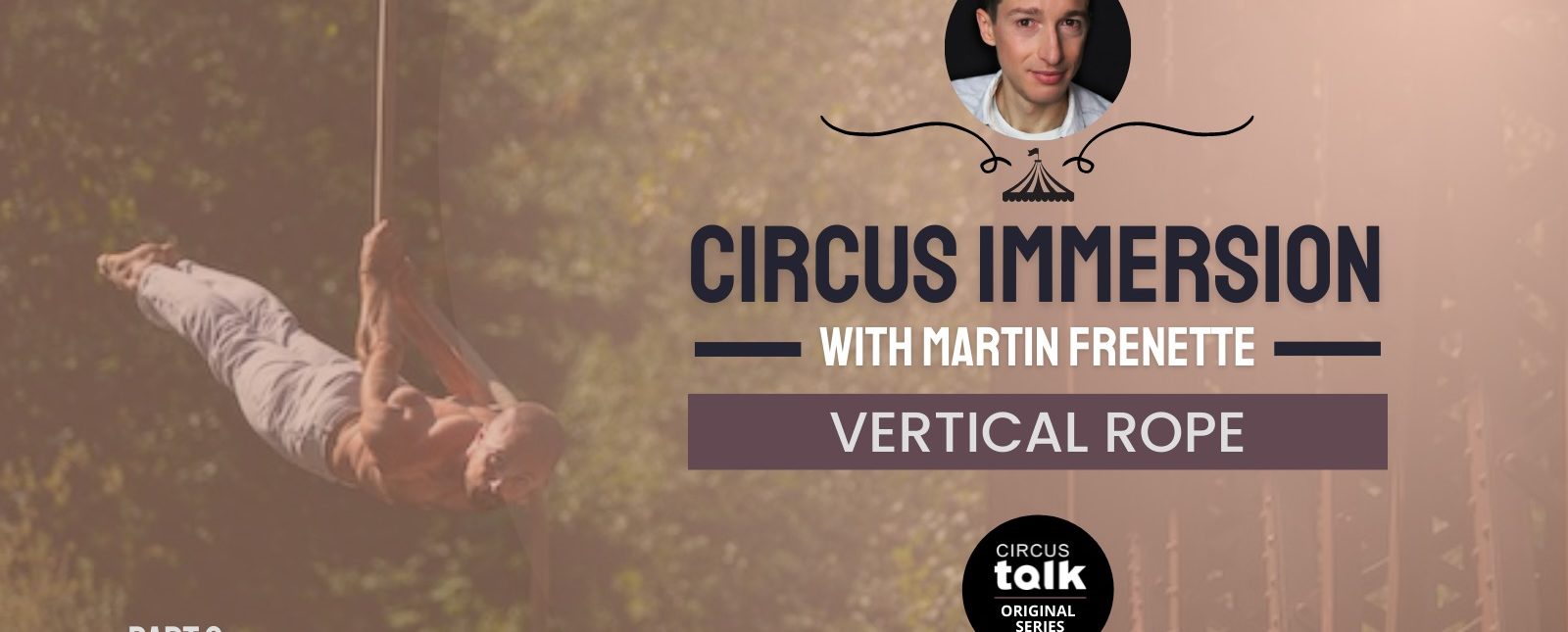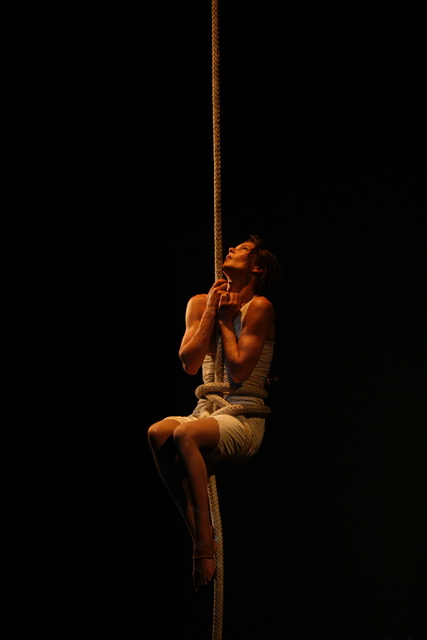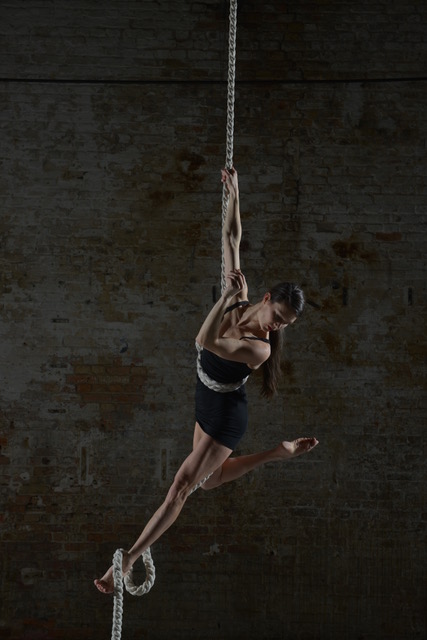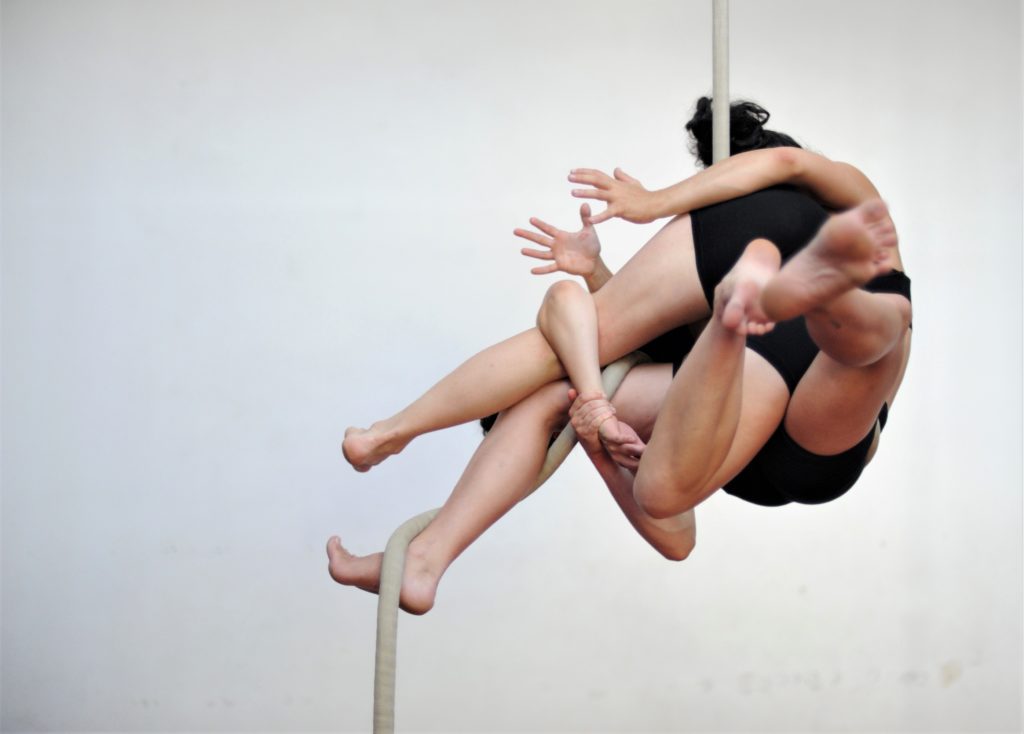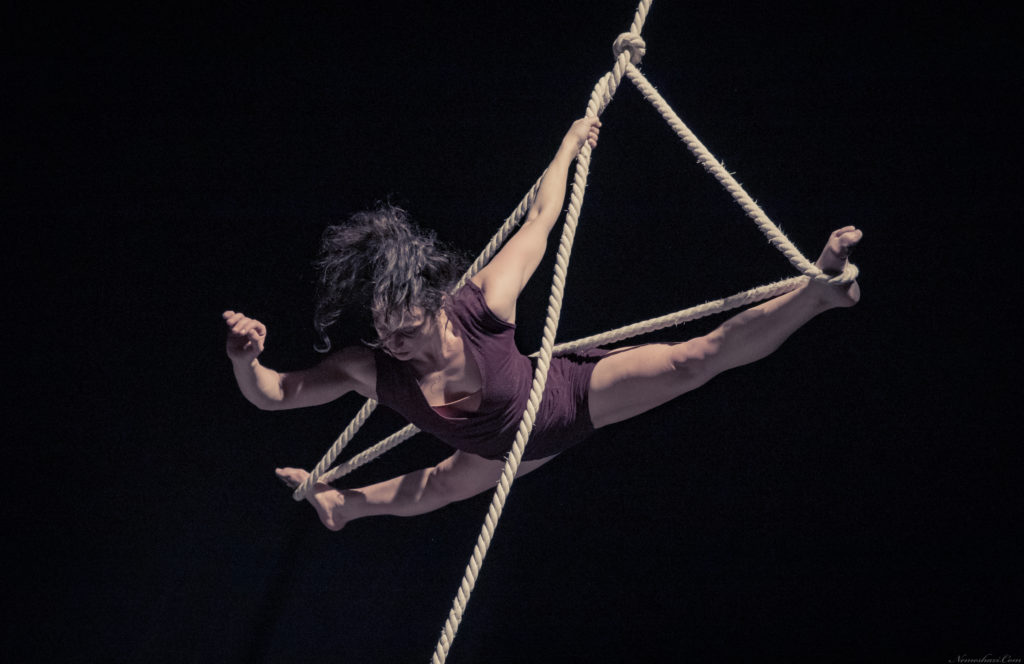Circus Immersion–Wrapping Up and Dropping Down
The crowd keeps on cheering and clapping for the tamer stealing an extra bow as lions and tigers exit one by one. Without missing a beat, stagehands immediately start tearing down and removing the cage panels surrounding the ring. The speed and agility with which they remove, nearly juggling bars away, might impress some, but the tamer’s wife has taken center stage to climb on a rope. That is how vertical rope was seen for many years: as a filler act.
Long before hip key and windmill became terms as common as multiplex or flash, very few cared about a rope hanging from the grid. Traditional circuses used it to reach a trapeze, for a quick Spanish web spin, or during those teardowns. In the same way, stagehands remove sawdust from felines’ pedestals, the contemporary circus movement dusted off the long hanging thread, turned it into a full artistic presentation, and made it a popular discipline in circus schools. Severing ties with tamers’ wives and tradition, creative minds found new methods of storytelling by wrapping up and dropping down in ways that other aerial apparatus did not allow. Some researched the perfect way to get from the very top to an inch off the ground while others worked on finding the most elaborate and intricate wrap in which audiences would get lost without getting lost themselves!
“You cannot get lost on the rope. You must always know where you are, how much tail is on the ground, and how far you are from the top,” says Romy Seibt. At a time where most of her friends’ and colleagues’ interest was in the (then new) aerial fabric, the young woman found herself drawn to what coaches and students described as the “painful prop” at Berlin’s die Etage. Its simplicity and its chameleon nature that allowed infinite shape possibilities were and still are important reasons for the unique connection she has with the apparatus. The Dresden-native describes improvisation moments as very freeing, like meditation or therapy.
“A rope is a rope, that’s it. No faking around! It also fits me better–physically, with the strength it requires and the way my body moves with and around it. I’ve also never been one to follow trends, finding my own way of moving and expressing myself always felt more important. That’s what I got out of 20 years of rope practice.” Such a statement explains the frank and spontaneous “EVERYTHING” she exclaims when asked about how much of herself she has put in her aerial vocabulary.
A rope is a rope, that’s it. No faking around!
Feeling a strong possibility to go deeper each time she’d climb, Seibt spent hours simply researching, researching, and researching some more. With a somewhat embarrassed smile, she admits to being unable to talk about anything but her rope in those early days. The dynamic woman then adds that in spite of spending an important part of her career performing Akita, her signature act, a sense of stagnation never hit as both the piece and the artist subtly and constantly changed, show after show. The trust in the movement gained over time convinced her that those moves could touch an audience and express as much as a literal story. For this former duo trapeze partner, that aerial epiphany meant no longer wanting to hide behind a story or a colleague to feel relevant.
After a deep moment of reflection, the mother of two describes the touch of a rope as a very active and mindful feeling. The fact that one can always decide how strong their grip is or how fast a drop goes also gives a strong sense of willpower and decisiveness to rope practitioners. Seibt then affirms that her vertical partner offers her the best in-between as an act can’t be solely influenced by height or the ground. An inspiring piece is about both and neither. Since being too high or too low will tremendously impact any trick and every artist, an equal awareness of both opposites is required.
From Berlin to Seattle
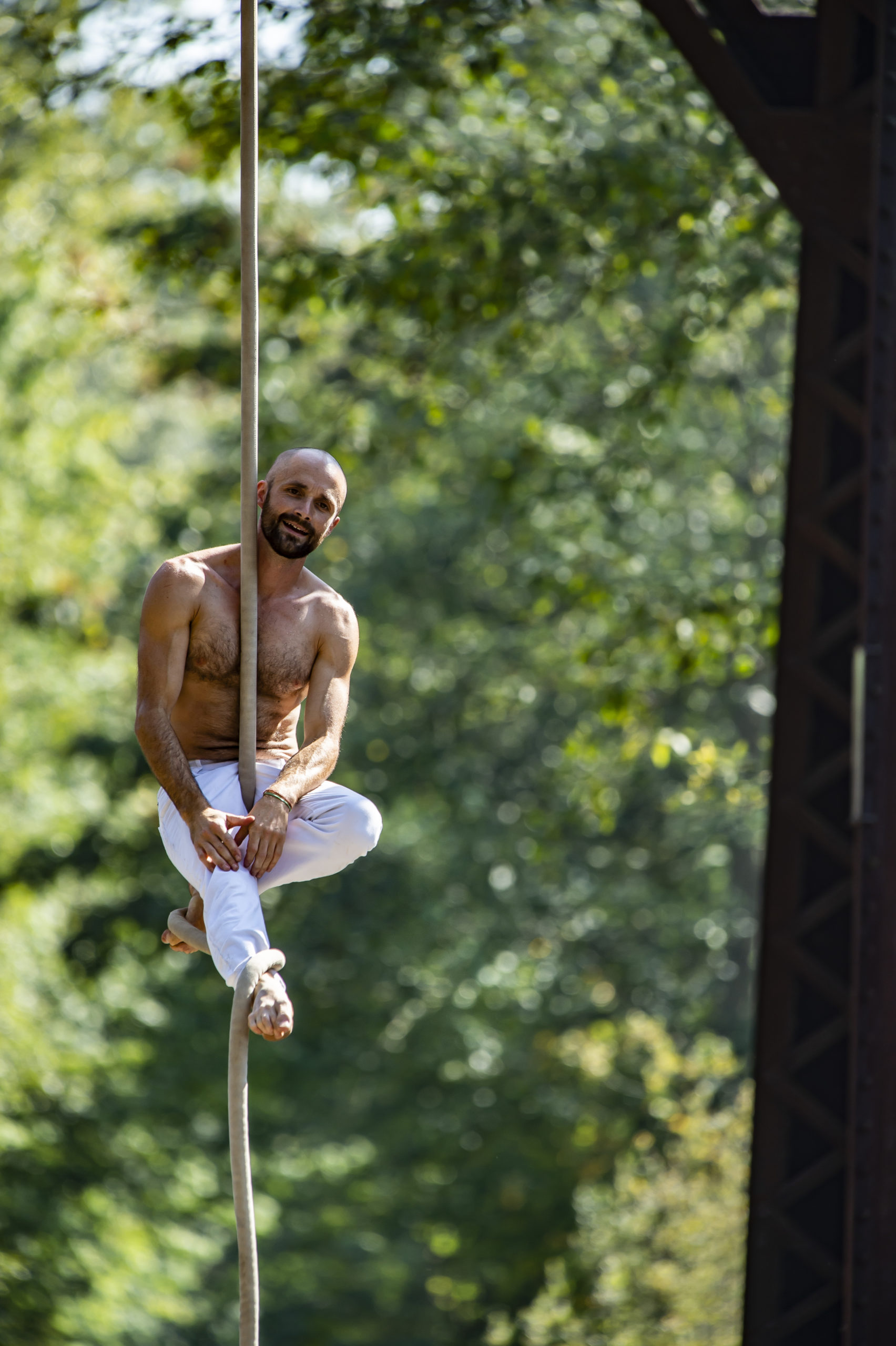
Terry Crane agrees, adding that there is something extreme and dangerous about a human hanging high off the floor. Much like his German colleague, the 40-year-old mentions vertical rope’s simplicity and versatile nature as influential factors behind this long-lasting partnership. “I’m getting older and no longer have crazy shoulders. However, the rope is still there, offering infinite possibilities for storytelling.”
Crazy shoulders and big drops have made his reputation since graduating from Montreal’s Ecole nationale du cirque in 2006. Feeding off each other’s creativity, student Crane and his coach strived to build a piece essentially composed of original tricks created prior to Youtube and Instagram’s birth. Combining existing drops, adding changes of directions or an extra element on top of the wrap were both men’s lines of work. Surprising the audience was the young artist’s main goal.
A rope is a tool that has existed forever, a well-known object that can evoke imprisonment or captivity while also finding its place on a playground.
“I’m now more invested in storytelling than technique, but a rope’s simple nature at its core makes it possible. It can be just a backdrop and disappear, or be used and personified as a character,” adds the Seattle aerialist. He then underlines that a rope is a tool that has existed forever, a well-known object that can evoke imprisonment or captivity while also finding its place on a playground.
A rope being a single point to which one holds onto results in the movement being more circular than with other more squared apparatus. These other disciplines don’t have tricks performed without hands, this vocabulary is really specific to the vertical rope. A sequentiality of dropping one leg first and using one side at a time is another important choreographic component. Finally, there is this tail, floating in the air or caressing the ground. It offers plenty to play with. “No other apparatus lends itself to that kind of slack manipulation,” concludes Crane.
Looking at 13 years spent going from one show to the next, from Circus Starlight to Teatro Zinzanni and countless stages in between, the inspired artist acknowledges that being a fast mover and delivering tricks at a quick pace allowed him to stand out early on. He later tried but struggled at slowing down and being more lyrical. An encounter with dancer-choreographer KT Niehoff in 2014 opened him to new horizons and developed his interest in smoother, more sensual movements. Having never been good at remembering choreography, Crane realized that he could breathe, relax, and still be interesting through improvisation and a movement approach with close to nothing in common with his infamous drops.
“KT had a huge impact on the way I move and create on the rope. I now want to be very honest and express true feelings in my pieces. The movement comes from my heart while remaining acrobatic. I want the audience to relate to what I feel on the rope. Having experienced many styles and gone through all these incarnations has allowed me to do so.”
Wrapping it up in Budapest
Still in her 20’s, but with already a decade of ascending and descending on her hands, Gaia Santuccio would nod if her fellow “ropist” were in her Budapest’s flat. A broad variety of experiences in physical theater and other forms of ground movements led the young Italian to venture into the air. “From my first encounter with a rope in Bristol, I liked how simple and rough it could be. I was inspired by all the movement and new creative possibilities that I could benefit from.”
Striving to expand her movement vocabulary, the former mime student started exploring what could be done off the ground after parting ways with a stage partner. Independence and not having to rely on anyone or anything are the first lessons she got from her rope practice. Anything but that rope!
Feeling that tricks performed with pointed toes and straight legs were deprived of personality, Santuccio opted for a more intimate, somewhat rougher, and creative approach. She however insists on the importance of good technical training when it comes to the vertical rope. If only to build strength and amplify one’s movement repertoire.
Referring to her rope as a companion and a friend, she also sees it as the most versatile stage partner. One that can create its own movements and be an equal subject instead of a simple object that one manipulates. With countless ways of being used between earth and air, the rope connects both, can be manipulated into shapes, and follows one in all directions.
“I’ve relearned to move on the ground to better understand and integrate those movements into my rope pieces. My aerial work has strengthened my connection to the ground. Rope artists benefit from such a connection. Be open, curious, and look at everything surrounding you to get the most out of your research!” she suggests with undeniable enthusiasm.
When asked about the skills and traits that best describe her discipline’s community, the London Circus Center’s alumna highlights an ability to react quickly and think faster. She sees rope artists as very aware, decisive people who understand tricks with both body and head. This ability to stay calm and understand a wrap or a knot just by looking at it is extremely valuable and one that every rope practitioner should master for the day they’ll get lost in a trick or a wrap.
With the restrictions and isolation that the community has had to face, vertical rope’s next chapter will be marked by the 2020’s pandemic in terms of the changes and new approach that will come out of it. Inspired by what has already been explored, the master’s in contemporary circus arts student remains confident for her people. “We’ll survive by finding new ways to share our passion. Aerialists will hopefully stop to wait for those 8 meters of height to climb and give it a try. More action, more creation, and less waiting. That’s rope’s next chapter!”
Back in the United States and invested in his upcoming solo show, Crane thinks that “lasso tricks” will get bigger and gain in popularity, just as pirouettes and dynamic tricks will. As for German aerial veteran Seibt , she hopes for a deeper exploration of the rope in all its incarnations and a pursuit of these release tricks that scare her at times.
At its heart, Crane says, “Vertical rope is about ascending and descending in an acrobatic and lyrical fashion to share some sort of artistic vision with an audience. The height used can express lightness and freedom.”
All photos provided courtesy of Martin Frenette. Main image Terry Crane of Acrobatic Conundrum suspended from bridge....
Do you have a story to share? Submit your news story, article or press release.

